Xanthium sibiricum – cang er zi,Xanthii Fructus,cang er zi san,cang er,cang er san,cang er zi herb,cang er zi pian,cang er zi tang,cang er zi wan,fructus xanthium sibiricum,xanthium sibiricum fruit,Xanthium sibiricum
Xanthium sibiricum, a Chinese medicine. It is the mature fruit with involucre of Xanthium sibiricum Patr. of the Asteraceae family. It has the effects of dispersing wind and cold, clearing the nasal passages, removing rheumatism and relieving pain. It is mainly used to treat colds caused by wind and cold, sinusitis, rheumatic pain, urticaria, scabies and leprosy.
Xanthii Fructus
Other names
Xanthii Fructus, Yangfulai, Zhici, Daorentou, Xanthium Fructus, Niuchizi, Huqinzi, Cotton Mantis, Xanthium, Hucanzi
Nature and flavor
Tastes spicy and bitter, warm in nature; enters the lung meridian
Toxicity
Toxic
Classification of medicinal materials
Plant
Effects and effects
Disperse wind and cold, clear the nasal passages, remove rheumatism and relieve pain.
Indications
1. Colds caused by wind and cold: This product is spicy and warm, which can disperse wind and cold, clear the nasal passages and relieve pain. It is used to treat exogenous wind and cold, aversion to cold and fever, headache and body pain, and nasal congestion and runny nose.
2. Nasal sinusitis: This product is mild and unblocked, with a pungent taste that dispels wind, bitter and dry dampness, and is good at clearing the nasal passages to remove nasal congestion, stop forehead and nasal swelling and pain, and is used to treat nasal sinusitis headache, inability to smell fragrance and odor, and occasional turbid nasal discharge.
3. Rheumatic arthralgia: This product is pungent, dispersing, bitter and dry, warm and cold, can dispel wind and dampness, dredge meridians and relieve pain, and is used to treat rheumatic arthralgia, joint pain, and cramps in the limbs.
Usage and dosage
For oral use: decoction, 3-10g; or into pills or powders. For external use: mash and apply; or wash with decoction.
Adverse reactions
1. Poisoning is mainly kidney damage, causing azotemia, congestion of the liver, fatty degeneration, and acute damage to liver function; secondary cerebral edema, causing tonic spasm, and finally leading to death.
2. Early symptoms include dizziness, headache, general discomfort, nausea, vomiting coffee-colored substances, mild abdominal distension, accompanied by diarrhea or constipation; severe cases include irritability, restlessness, or fatigue, lethargy, thirst, oliguria, coma, generalized tonic spasm, jaundice, hepatosplenomegaly, liver dysfunction, protein, red blood cells, and casts in the urine, and death due to respiratory, circulatory, and renal failure.
3. The main causes of Xanthium sibiricum poisoning are excessive dosage (more than 30 grams or 10 pieces at a time) and improper processing. Therefore, the dosage should be strictly controlled, 3-9g is appropriate for decoction, and the processing specifications should be strictly followed, following the principle of removing thorns.
4. The general treatment for Xanthium sibiricum poisoning is: early intravenous rehydration and detoxification; gastric lavage with 1:2000 potassium permanganate solution within 12 hours, high colon enema with warm saline, vomiting, and catharsis; to prevent heart failure, add 100 mg of hydrocortisone to glucose solution once a day, and norepinephrine can be added to the liquid for those with low blood pressure; oral or injection of vitamin B1.
Précautions
It is not suitable for people with blood deficiency and headache. Overdose can easily cause poisoning.
Chemical composition
Contains volatile oils, sterols such as Xanthium sibiricum glycosides, fatty oils, organic acids and proteins, vitamin C, etc. Its toxic components are toxin proteins, hydroquinones and toxin glycosides.
Effets pharmacologiques
1. Antimicrobial effect: Xanthium sibiricum decoction has a strong antibacterial effect on Staphylococcus aureus and anthrax bacteria in vitro, and also has an antibacterial effect on Streptococcus pneumoniae, Streptococcus B and Corynebacterium diphtheriae. The antibacterial effect of fried products is stronger than that of raw products. The acetone or ethanol extract of Xanthium sibiricum has antifungal effect on Trichophyton rubrum, and its decoction has antifungal effect on Trichophyton rubrum. The direct inhibition rate of Xanthium sibiricum decoction on hepatitis B virus DNA polysaccharide (DNAP) in vitro is 25%-50%, indicating that it has anti-hepatitis virus effect. When the Xanthium sibiricum extract is diluted 1:10, it can inhibit 100TCID50 herpes virus. Within the drug concentration range used, the Xanthium sibiricum extract has no effect on normal cells.
2. Hypoglycemic effect: AA2, a glycoside extracted from the Xanthium sibiricum water extract, is a toxic component with hypoglycemic effect. Intraperitoneal injection of 1.25-5mg/kg can significantly reduce blood sugar in normal rats. When the dose reaches 10mg/kg, blood sugar can be reduced to convulsion level (35-45mg%) 2h after administration. AA210mg/kg has a significant effect on reducing liver glycogen in rats and mice. AA2 can also counteract the blood sugar-raising effect of adrenaline. The blood sugar-lowering mechanism of AA2 may be different from that of insulin, but similar to that of phenformin. Carboxy-atractyloside, a component of Xanthium sibiricum, can significantly reduce blood sugar in normal rabbits, rats and dogs when taken orally or injected, and can also reduce blood sugar in rats with alloxan diabetes.
3. Effects on cardiovascular system: Xanthium sibiricum decoction has an inhibitory effect on isolated frog hearts and guinea pig hearts, slowing down heart rate and weakening cardiac contractility, and can dilate rabbit ear blood vessels, while frog blood vessels first dilate and then contract. Intravenous injection of Xanthium sibiricum injection can temporarily reduce blood pressure in rabbits and dogs. Glycoside component AA2 has a mild hypotensive effect on rats and can enhance vascular permeability.
4. Effects on the blood system: 0.2g (raw drug)/ml of Xanthium sibiricum extract can significantly prolong the time for bovine thrombin to coagulate human fibrinogen, and has a significant antithrombin effect. Xanthium sibiricum methanol extract can quickly restore the cholesterol and triglyceride levels of rabbits caused by fasting to normal, and also increase the phospholipid content to a certain extent.
5. Effect on immune function: Xanthium sibiricum decoction 0.5g (raw drug)/mouse gavage once a day for 10 consecutive days. Hemolytic plaque test (PFC), macrophage phagocytosis test and leukocyte migration inhibition test showed that Xanthium sibiricum had a significant inhibitory effect on the cellular immunity and humoral immunity of C57/BL purebred mice. Xanthium sibiricum reduced the number of helper T cells (TH) and suppressor T cells (TS), and reduced the TH/TS ratio. Xanthium sibiricum significantly reduced β-endorphin in the hypothalamus and plasma. In addition, Xanthium sibiricum can reduce the activity of interleukin-2 (IL-2) and the content of IL-2 receptors, and can significantly reduce the release of intracellular histamine, which is one of the mechanisms by which Xanthium sibiricum can be used to treat allergic diseases.
6. Antioxidant effect: 0.5g of Xanthium sibiricum decoction was administered orally once a day for 10 consecutive days. It can effectively reduce lipid peroxidation, reduce the content of tissue lipid peroxidation (LPO), and increase the activity of superoxide dismutase (SOD), indicating that Xanthium sibiricum can enhance the body’s ability to scavenge free radicals and reduce the damage of free radicals to the body.
7. Other effects: The hot water extract of Xanthium sibiricum has an inhibition rate of 50%-70% on cervical cancer cells in vitro. Modern bioanalysis tests have shown that the extract of Xanthium sibiricum has different degrees of inhibitory effects on angiotensin receptors, β-hydroxy-β-methylglutaryl coenzyme A, calcium channel blocker receptors and cholecystokinin.
Toxicological effects
The toxic components of Xanthium sibiricum are soluble in water, and the LD50 of its water extract injected intraperitoneally into mice is 0.93g/kg. The poisoning symptoms of rats, mice, guinea pigs and rabbits administered by different routes are basically the same, mainly reduced activity, slow response to external stimuli, irregular breathing, extreme difficulty breathing before death and accompanied by paroxysmal convulsions. Pathological tissue examination showed that the liver had degenerative degeneration or necrosis; the epithelial edema of the renal convoluted tubules was turbid and swollen, and there were protein casts in the lumen; the lungs and brain were congested and edematous. The heart was slightly turbid and swollen. Among them, the liver damage was the most serious, similar to carbon tetrachloride damage, and the convulsions caused by secondary cerebral edema may be the direct cause of death; the strong convulsions that occurred after animal poisoning were also related to extreme hypoglycemia. The absolute lethal dose LD100 of 25% Xanthium sibiricum emulsion for rabbits by intraperitoneal injection was 10ml/kg; the LD50 of intraperitoneal injection in mice was 7.5ml/kg. The LD50 of intraperitoneal injection of glycoside AA2 in mice and rats was 10mg/kg and 4.6mg/kg respectively. The LD50 of intraperitoneal injection of potassium carboxy atractylodes acid in mice was 10.7mg/kg. The LD50 of carboxy atractylodesin for intraperitoneal injection, subcutaneous injection and oral administration in mice were 2.9mg/kg, 5.3mg/kg and 350mg/kg respectively. The maximum tolerable dose of the alcohol extract of Xanthium sibiricum decoction was 138 times the common dose of 9g for adults after oral administration of Kunming mice once.
Related Discussions
1. “Shennong’s Herbal Classic”: It is used to treat wind-head cold pain, rheumatism, cramps and pain in the limbs, and dead muscles.
2. “Compendium of Materia Medica”: It is good at sweating, dispersing rheumatism, connecting the top of the brain, going down to the feet and knees, and reaching the skin. It can treat headaches, dark eyes, toothaches, sinusitis, and remove thorns.
Clinical Application
1. It can be used together with other wind-cold dispersing drugs such as Saposhnikovia divaricata, Angelica dahurica, Notopterygium incisum, and Ligusticum chuanxiong for treating exogenous wind-cold, aversion to cold and fever, headache and body pain, and nasal congestion and runny nose.
2. Treat nasal sinusitis with headache, loss of smell, and occasional runny nose. This medicine has several effects and treats both the symptoms and the root cause. It can be taken orally or applied externally. It is a good medicine for treating nasal sinusitis, especially for those with nasal sinusitis and exogenous wind-cold. It is often used with Xinyi, Baizhi and other wind-cold-dispersing and nasal-clearing medicines, such as Xanthium sibiricum powder (Jisheng Fang). If the nasal sinusitis is caused by external wind-heat or internal damp-heat, this product is often used with mint, scutellaria and other wind-heat-dispersing and heat-clearing medicines.
3. Treat rheumatic arthralgia, joint pain, and limb cramps. It can be used alone or with Qianghuo, Clematis, papaya and other medicines.
4. Treat urticaria and itching, and use it with Kochia scoparia, Dictamni, Tribulus terrestris and other medicines.
Related combinations
1. Xanthium sibiricum with Ephedra: Both can dispel wind-cold and clear the nasal passages. The combination of the two medicines is often used to treat colds, nasal congestion and runny nose, as well as headaches caused by sinusitis, nasal congestion and runny nose.
2. Xanthium sibiricum and Clematidis: Xanthium sibiricum can dispel rheumatism and relieve pain; Clematidis is good at dispelling rheumatism, unblocking meridians, and relieving pain. The combination of the two can dispel rheumatism, unblock meridians, and relieve pain. It is often used to treat rheumatism and body pain.
3. Xanthium sibiricum and Saposhnikovia divaricata: Both can dispel wind and relieve itching, and the combination is more effective. It is often used to treat itching caused by wind evil.
Identification of medication
1. Xanthium sibiricum, Xanthium sibiricum leaves and Xanthium sibiricum worms: Xanthium sibiricum is the fruit of Xanthium sibiricum, which is pungent, bitter and warm in nature. It mainly relieves wind, removes dampness and raises yang, and relieves pain. It is often used to treat exogenous wind-cold, rheumatism, headache, sinusitis, rubella, leprosy, etc.; Xanthium sibiricum leaves are the stems and leaves of Xanthium sibiricum, which are pungent, bitter and slightly cold in nature. They have the functions of dispelling wind, clearing heat and detoxifying, and are mainly used for rheumatism, furunculosis, swelling and poisoning, etc.; Xanthium sibiricum worms are a kind of insect larvae living in the stems of Xanthium sibiricum, which have the function of reducing swelling and detoxification, and can treat carbuncle, furunculosis, hemorrhoids, etc., and are exclusively for external use.
2. Xanthium sibiricum and Pittosporum tobira bark: Both can dispel wind, dampness and insecticide, and have the functions of relieving pain and itching. They can be used for joint pain caused by rheumatism and tendons and bones, or scabies, scabies, rashes and itching caused by rheumatism. However, the bark of Pittosporum tobira is mild in nature and good at removing dampness, and its effect is biased downward, so it is more suitable for heat arthralgia and damp-heat descending to the waist and legs, and it can also be used for damp-heat diarrhea. Xanthium sibiricum is warm in nature and tends to dispel wind, and its effect is biased upward. It also has the effects of sweating, relieving the exterior, and clearing the nasal passages, so it is more suitable for treating severe arthralgia caused by cold, and is often used for headaches, nasal congestion, and nasal sinusitis caused by exogenous wind and cold.
Related medicines
Bitong pills, drops to relieve rhinitis water, and Libi tablets.
Related prescriptions
Xanthium sibiricum powder (Jisheng Fang).
Processing and preparation
Harvesting and processing
In September and October, when the fruits are ripe, turn from green to yellow, and most of the leaves have withered and fallen off, choose a sunny day, cut the whole plant, thresh, winnow, and dry it.
Processing method
1. Xanthium sibiricum: Take the original medicinal materials and remove impurities.
2. Stir-fried Xanthium sibiricum: Take the clean Xanthium sibiricum and put it in a pot. Stir-fry it over medium heat until the surface is yellow-brown and the aroma escapes. Take it out and let it cool, remove the thorns, and sieve it.
3. Fried Xanthium sibiricum with bran: Sprinkle bran into a hot pot and heat over medium heat. When it smokes, add clean Xanthium sibiricum and stir-fry until the surface turns dark yellow. Take it out, sieve out the bran, and let it cool. Grind to remove the thorns. Sieve out the ash. For every 100kg of Xanthium sibiricum, use 45kg of bran.
Storage method
Store in a dry container. Stir-fried Xanthium sibiricum and fried Xanthium sibiricum with bran are sealed and placed in a cool and dry place.
Identification of medicinal materials
1. The powder of this product is light yellow-brown to light yellow-green. The fibers of the involucre are bundled, often arranged in a vertical and horizontal cross pattern. The epidermal cells of the pericarp are brown, rectangular, and often connected to the fibers of the lower layer. The pericarp fibers are bundled or scattered individually, slender and fusiform, with obvious or inconspicuous pits and grooves. The seed coat cells are light yellow, the outer cells are polygonal, and the walls are slightly thick; the inner cells have papillary protrusions. The wood parenchyma cells are rectangular and have pits. The cotyledon cells contain fuzzy powder and oil droplets.
2. Take 2g of the powder of this product, add 25ml of methanol, ultrasonically treat for 20 minutes, filter, and concentrate the filtrate to 2ml as the test solution. Take 2g of Xanthium sibiricum as the control medicinal material. Prepare the control medicinal material solution in the same way. According to the thin layer chromatography method (General Rule 0502), take 4μl of each of the above two solutions and spot them on the same silica gel G thin layer plate, use the upper layer solution of n-butanol-glacial acetic acid-water (4:1:5) as the developing agent, develop, take out, dry, and fumigate in ammonia vapor until the spots are clearly colored. In the chromatogram of the test product, spots of the same color appear at the corresponding position of the chromatogram of the control medicinal material.
Medicinal material properties
The fruit is wrapped in the involucre, spindle-shaped or oval, 1-1.5cm, and 0.4-0.7cm in diameter. The surface is yellow-brown or yellow-green, with hooked thorns all over, and two thicker thorns at the tip, separated or connected, with stalk marks at the base. Hard and tough, with a septum in the middle of the cross section, 2 chambers, each with 1 achene. Achenes are slightly fusiform, with one side relatively flat, and a protruding stylopodium at the tip. The pericarp is thin, gray-black, and has longitudinal stripes. The seed coat is membranous, light gray. There are longitudinal stripes; there are 2 cotyledons, which are oily. The smell is slight and the taste is slightly bitter.
Decoction properties
1. Xanthium sibiricum: It is flat spindle-shaped or flat oval, 1-1.5cm long and 0.4-0.7cm in diameter. The surface is yellow-brown or yellow-green, with hooked thorns all over, and there are 2 thicker thorns at the top, separated or connected, with fruit stalk marks at the base. The body is light, hard and tough, with a longitudinal septum in the middle of the cross section, 2 chambers, each with 1 achene, slightly fusiform, with one side relatively flat, and a protruding stylopodium at the top. The pericarp is thin, gray-black, and has longitudinal stripes. The seed coat is membranous, light gray, and there are 2 cotyledons, which are oily. Slight smell, slightly bitter taste.
2. Stir-fried Xanthium sibiricum: It looks the same as Xanthium sibiricum, but with a yellow-brown surface and densely covered with many hook marks. It has an aroma.
Common counterfeits
Confusing products:
Northeast Xanthium sibiricum: This product is the dried fruit with involucre of the Northeast Xanthium mongolicum Kitag plant of the Asteraceae family. It is spindle-shaped, 1.5-2.4cm long and 1-1.3cm in diameter. The surface is yellow-brown or dark brown, densely covered with relatively coarse and hard hooks, 2-3.5mm long, with 2 thicker thorns at the top, separated, mostly slightly curved inward, 3-5mm long. There is a fruit stalk mark at the base. It is hard and tough, with 2 chambers, the pericarp is thin, gray-black, and has longitudinal stripes. The seed coat is membranous, light gray, and the cotyledons are oily. Slight smell, light taste.
Xanthium sibiricum, a plant of the Asteraceae family.
Morphological characteristics
Annual herb, 20-90cm high. The root is spindle-shaped, branched or unbranched. The stem is erect, unbranched or rarely branched, cylindrical at the bottom, with longitudinal grooves at the top, and covered with grayish-white rough hairs. Leaves are alternate; with long petioles, 3-11 cm long; leaf blades are triangular-ovate or cordate, 4-9 cm long, 5-10 cm wide, nearly entire, or with 3-5 inconspicuous shallow lobes, with pointed or obtuse tips, three veins at the base, green above, pale below, and covered with rough or short white hairs. The capitula is nearly sessile, aggregated, and monoecious; the male inflorescence is spherical. The involucral bracts are small, in 1 row, densely pubescent, the receptacle is columnar, the receptacle is oblanceolate, the florets are tubular, the apex is 5-toothed, the stamens are 5, and the anthers are oblong-linear; the female inflorescence is ovate, the involucral bracts are 2-3 rows, the outer row bracts are small, the inner row bracts are large, forming a capsule-shaped ovate, a hard body with 2 chambers, with barbed hairs on the outside, and 2 conical tips on the top, 2 florets, no corolla, the ovary is in the involucral bract, each chamber has 1 flower, the style is linear, protruding outside the involucral bract. The mature involucral bract with achenes becomes hard, ovate or elliptical, 12-15mm long and 4-7mm wide with the beak, green, light yellow or reddish brown, with sparse hooked involucral spines on the outside, the involucral spines are thin, 1-1.5mm long, not thickened at the base, and the beak is 1.5-2.5mm long; there are 2 achenes, obovate. The achenes contain 1 seed. The flowering period is from July to August, and the fruiting period is from September to October.
Where is the main production area of Xanthium sibiricum?
It is mainly produced in Shandong, Jiangsu and Hubei.
Xanthium sibiricum Where is the main medicinal part of Xanthium sibiricum?
Medicinal part of Xanthium sibiricum:
This product is the dried, mature fruit with involucre of Xanthium sibiricum Patr., a plant of the Asteraceae family. Harvested in autumn when the fruit is ripe, dried, and the stems, leaves and other impurities are removed. Characteristics of the medicinal part of Xanthium sibiricum:
This product is spindle-shaped or oval, 1~1.5cm long, 0.4~0.7cm in diameter.
The surface is yellow-brown or yellow-green, with hooked thorns all over, 2 thicker thorns at the top, separated or connected, and with fruit stalk marks at the base. It is hard and tough, with a longitudinal septum in the middle of the cross section, 2 chambers, and 1 achene in each. The achene is slightly spindle-shaped, with a relatively flat side and a protruding stylopodium at the top. The pericarp is thin, gray-black, and has longitudinal stripes. The seed coat is membranous, light gray, with 2 cotyledons, and oily. Slight smell, slightly bitter taste
How are Xanthium sibiricum recorded in ancient books?
“Ben Jing”: “It is used to treat wind-induced cold pain in the head, rheumatism, stiffness and pain in the limbs, and dead muscles.
“Rihuazi Materia Medica”: “It can treat all wind-induced diseases, …, scrofula, scabies and itching.
“Bencao Mengquan”: “It can stop headaches, clear the top of the head, chase away wind poison in the bone marrow, and kill malnutrition and dampness.
“Jingyue Complete Book·Bencao Zheng”: “It can treat sinusitis.
“Compendium of Materia Medica”: “Xanthium sibiricum is mild and unblocked, smoothes joints, dredges meridians, and spreads throughout the orifices and skin without being too dry. It is the most powerful and docile one for treating wind, cold and dampness. It can also reach the top of the head and dredge the wind and cold in the brain, making it an essential medicine for headache.
Effets
Xanthium sibiricum has the effects of dispersing wind and cold, unblocking nasal orifices, and removing rheumatism.
What are the main effects and clinical applications of Xanthium sibiricum?
Xanthium sibiricum is used for wind-cold headache, nasal congestion and runny nose, allergic rhinitis, sinusitis, urticaria itching, and dampness and stiffness.
Wind-cold exterior syndrome
For wind-cold exterior syndrome with obvious nasal congestion and runny nose, it can be used together with Saposhnikovia divaricata, Angelica dahurica, and Notopterygium wilfordii.
Huangyuan nasal track, nasal congestion and runny nose
Often used together with Magnolia officinalis, Asarum, and Angelica dahurica.
Bi syndrome
Treats wind-cold and dampness, joint pain, and limb stiffness. It can be used alone or with Notopterygium wilfordii, Angelica dahurica, and Weiling. Xian and other uses.
What other effects does Xanthium sibiricum have?
In my country’s traditional food culture, some Chinese medicinal materials are often widely consumed as food ingredients by the people, that is, according to the tradition, they are both food and Chinese medicinal materials (i.e. edible medicinal materials). According to the documents issued by the National Health Commission and the State Administration for Market Regulation, Xanthium sibiricum can be used as both medicine and food within a limited range of use and dosage.
Common medicinal diet recipes for Xanthium sibiricum are as follows:
Lacquer allergy
15g each of Tu Fuling and Xanthium sibiricum. Decoction in water, soak 30g of Liuyi powder and take
Note: The use of Chinese medicinal materials must be based on syndrome differentiation and treatment, and should be used under the guidance of professional Chinese medicine practitioners. They should not be used at will, and should not be used at will by Chinese medicine prescriptions and advertisements.
What are the compound preparations containing Xanthium sibiricum?
Biyuan Pills
Expel wind and clear the lungs, clear heat and detoxify, open the orifices and relieve pain. Used for nasal congestion and nasal Yuan, poor ventilation, runny yellow and turbid nasal discharge, loss of smell, headache, and pain in the brow bone.
Biyuanshu Capsules
Disperse wind and heat, remove dampness and open the orifices. Used for rhinitis and sinusitis caused by wind-heat in the lung meridian and stagnation of heat in the gallbladder
Sinusitis oral liquid
Disperse wind and heat, clear heat and remove dampness, and open the nasal orifices. Used for nasal congestion and thick yellow nasal discharge caused by wind-heat invading the lungs and internal accumulation of dampness and heat; acute and chronic rhinitis and sinusitis with the above symptoms.
Tongqiao Rhinitis Tablets
Disperse wind and consolidate the exterior, open the lungs and open the orifices. Used for nasal congestion that is sometimes light and sometimes heavy, clear or turbid nasal discharge, and forehead headache caused by wind-heat in the lungs and deficiency of the exterior; chronic rhinitis, allergic rhinitis, and sinusitis with the above symptoms.
Modern research progress on Xanthium sibiricum
Modern research results show that this product has anti-inflammatory, analgesic, immunosuppressive, antioxidant, anti-pathogenic microorganism, vasodilator, and hypoglycemic effects. And many other pharmacological effects.
Usage
Xanthium has the effects of dispersing wind and cold, clearing the nasal passages, and removing rheumatism. Xanthium is generally used as Xanthium slices for oral administration. Please follow the doctor’s instructions for specific medication.
How to use Xanthium correctly?
When Xanthium is decoctioned and taken orally, the common dosage is 3~10g.
When Xanthium is used externally, take an appropriate amount of Xanthium, pound it for application, or decoct it for washing.
Xanthium can be processed by different methods to produce Chinese medicinal materials such as Xanthium and fried Xanthium. Different processing methods have different effects, but the medication method is the same. Please follow the doctor’s instructions for specific medication.
Xanthium is generally used in decoctions, decoctions are taken, and powders or pills can also be made for consumption. However, the use of Chinese medicinal materials must be differentiated and treated, and should be used under the guidance of professional Chinese medicine practitioners. It should not be used at will, and it is even more forbidden to listen to Chinese medicine prescriptions and advertisements at will.
Note: Xanthium is poisonous and cannot be used as medicine at will. You must strictly follow the doctor’s instructions.
How to prepare Xanthium sibiricum?
· Xanthium sibiricum: Take the original medicinal material and remove impurities. Crush it when using.
Stir-fried Xanthium sibiricum: Take clean Xanthium sibiricum, put it in a stir-frying container, heat it over medium heat, stir-fry until the surface is yellow-brown and the thorns are burnt, take it out, cool it, grind it to remove the thorns, and sieve it. Crush it when using.
What drugs should be used with Xanthium sibiricum at the same time?
The combined use of Chinese medicine and the combined use of Chinese and Western medicine require syndrome differentiation and clinical individualized treatment.
Si vous utilisez d’autres médicaments, veuillez consulter un médecin avant de prendre le médicament et informez-le de toutes les maladies diagnostiquées et des plans de traitement que vous recevez.
Instructions pour les médicaments
Xanthium sibiricum is pungent and warm and toxic. Overdose can easily cause poisoning, vomiting, abdominal pain, diarrhea, etc. Therefore, the dosage should not be too large, and people with blood deficiency headaches should not take it.
What precautions should be taken when using Xanthium sibiricum?
It is not suitable for people with blood deficiency headaches; overdose can easily cause poisoning.
· During the medication period, you should pay attention to avoid eating cold, raw and cold foods, and avoid eating spicy and greasy foods.
· Pregnant and lactating women: If you are pregnant, planning to become pregnant or are lactating, please inform your doctor in time and consult whether Chinese medicine can be used for treatment.
· Enfants : Les enfants doivent prendre des médicaments sous la surveillance d’un médecin et sous la supervision d’un adulte.
· Please properly store the medicinal materials and do not give them to others.
· Avoid using copper or iron utensils to decoct medicine.
Conseils sur les médicaments
Questions les plus fréquemment posées par les patients
Efficacy and effects of fried Xanthium sibiricum
Xanthium sibiricum Patr is the dried, mature fruit with involucre of the Asteraceae plant Xanthium sibiricum Patr. Xanthium sibiricum tastes spicy and bitter, warm in nature; toxic. It belongs to the lung meridian. It has the function of dispersing rheumatism and clearing the nasal passages. The raw product has strong wind-clearing and itching-relieving power, and is mostly used for skin diseases such as itchy rash, scabies, etc.
Fried Xanthium sibiricum can reduce toxicity, tend to clear the nasal passages, dispel rheumatism, and relieve pain. It is often used for sinusitis headache and rheumatic pain.
Toxicity of Xanthium sibiricum Xanthium sibiricum Patr. is a dry, mature fruit with involucre of Xanthium sibiricum Patr., a plant of the Asteraceae family. Xanthium sibiricum Patr. is pungent, bitter, warm and toxic. Clinically, there are cases of poisoning after taking Xanthium sibiricum. The main causes of poisoning are direct ingestion of Xanthium sibiricum or young shoots, excessive intake of Chinese medicine preparations containing Xanthium sibiricum, and excessive use of topical ointments containing Xanthium sibiricum. The symptoms of poisoning are related to the amount of medicine entering the body. Generally, the disease occurs 2 to 3 days after the use of drugs containing Xanthium sibiricum, but it can develop acutely within a few hours to 1 day after taking Xanthium sibiricum. The main manifestations are nausea and vomiting, and the vomitus is mostly coffee-colored. There may also be abdominal pain and bloating, and a few have diarrhea or constipation, general weakness, headache, dizziness, thirst, and oliguria.
Contact dermatitis can be seen, and rashes appear on the contact parts of the limbs. In severe cases, hepatomegaly, jaundice, intestinal paralysis, extensive bleeding, liver failure, renal failure, shock and coma occur.
How to use Xanthium sibiricum to treat rhinitis
Xanthium sibiricum can be boiled in water for nasal fumigation and nasal cavity flushing, but it is a poisonous Chinese herbal medicine and has many side effects after taking it. Although it can treat chronic rhinitis and acute rhinitis, and has the effect of clearing the orifices and detoxifying, as a Chinese medicine formula for treating rhinitis, its dosage needs to be strictly controlled and it cannot be used alone or without authorization.
The use of Chinese herbal medicines must be based on syndrome differentiation and treatment, and should be used under the guidance of professional Chinese medicine practitioners. It cannot be used at will, and it is even more forbidden to listen to Chinese medicine prescriptions and advertisements at will.
Xanthium Sibiricum – Cang Er Zi
Plage de prix : $58.88 à $32,666.00
+ Livraison gratuiteXanthium sibiricum, [cang er zi], Chinese herbal medicine, alias: ear, cattle lice, Hu qinzi, Ba Langzhong, cotton mantis, Cangzi, English name: Xanthii Fructus, main effects: dispel wind and cold, clear the nasal passages, and eliminate rheumatism. The Chinese herbal medicine Xanthium sibiricum is a kind of antipyretic medicine. It is the dried and mature fruit with involucre of the plant Xanthium sibiricum of the Asteraceae family. Xanthium sibiricum is pungent, bitter, warm and toxic. It belongs to the lung meridian. Xanthium sibiricum is pungent, dispersing, bitter, dry, warm and unblocking. It is sweet and slow but not harsh. It has a little toxicity and is strong. It enters the lung meridian, dispels wind and cold, clears the nasal passages; enters the liver and meridians, dispels rheumatism, removes numbness and stops itching. It goes up to the top of the brain, goes down to the feet and knees, reaches the skin outside, and goes to the internal organs inside. It is best for treating exogenous infection or runny nose due to sinusitis and rheumatic itching. It is slightly toxic and should not be taken in excess or for a long time. This product mainly contains fatty acids, such as palmitic acid, stearic acid, oleic acid, linoleic acid; it also contains atractylodesin, chlorogenic acid, wax alcohol and other ingredients. It has the functions of dispersing wind and cold, clearing the nasal passages and removing rheumatism.
| Poids | 1kg, 10kg, 100kg, 500kg, 1000kg |
|---|
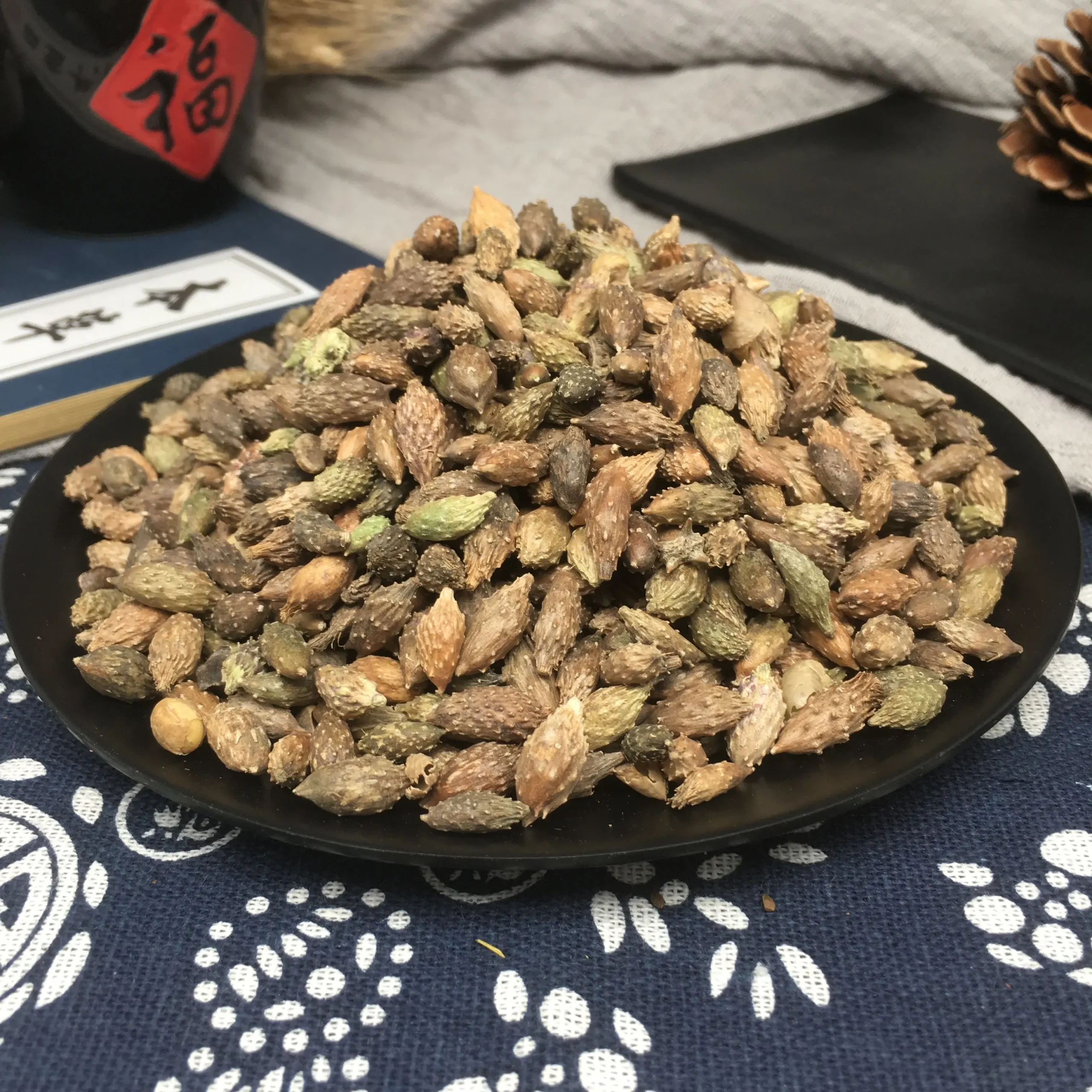

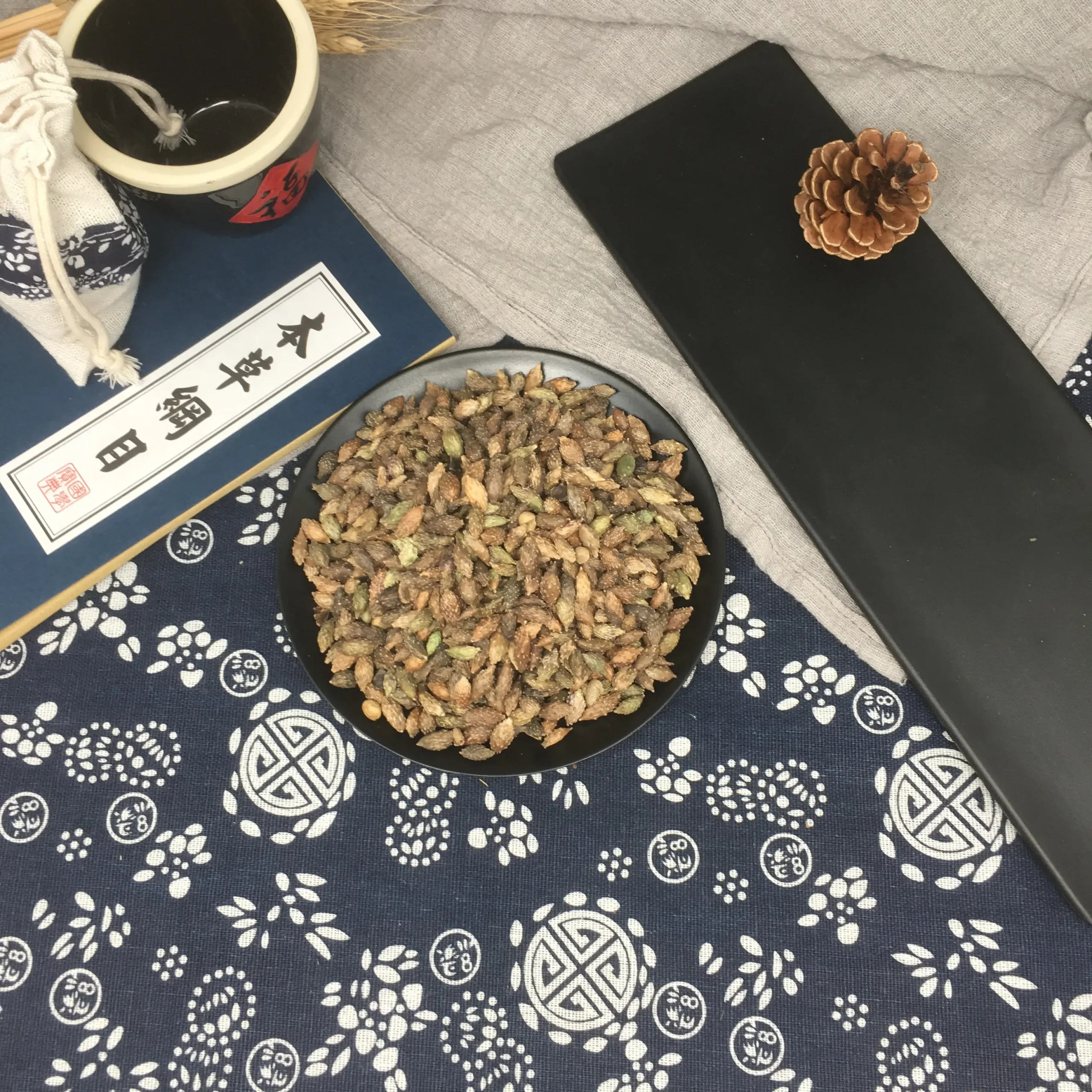
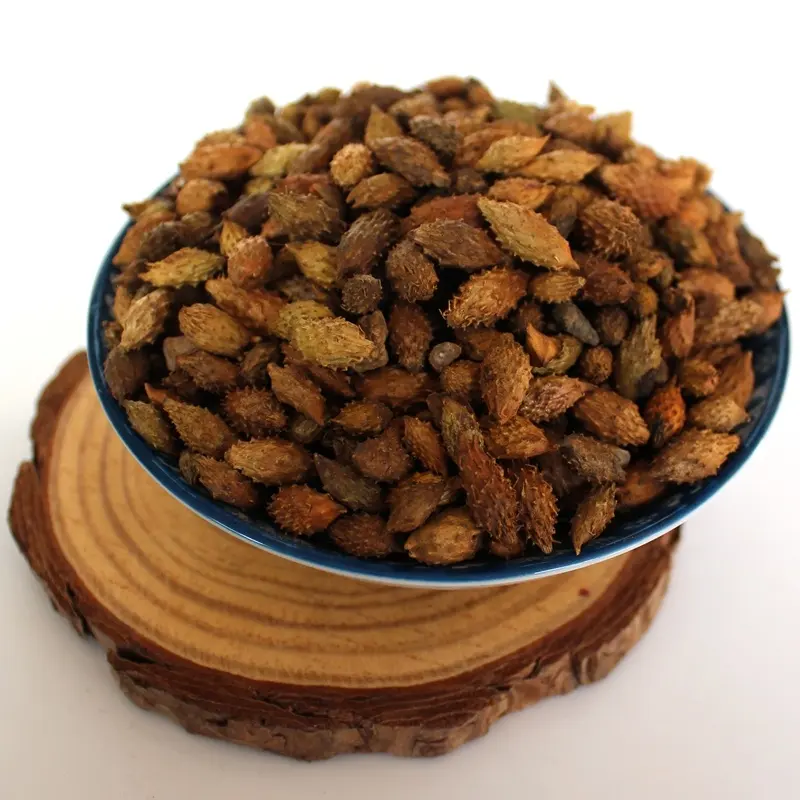


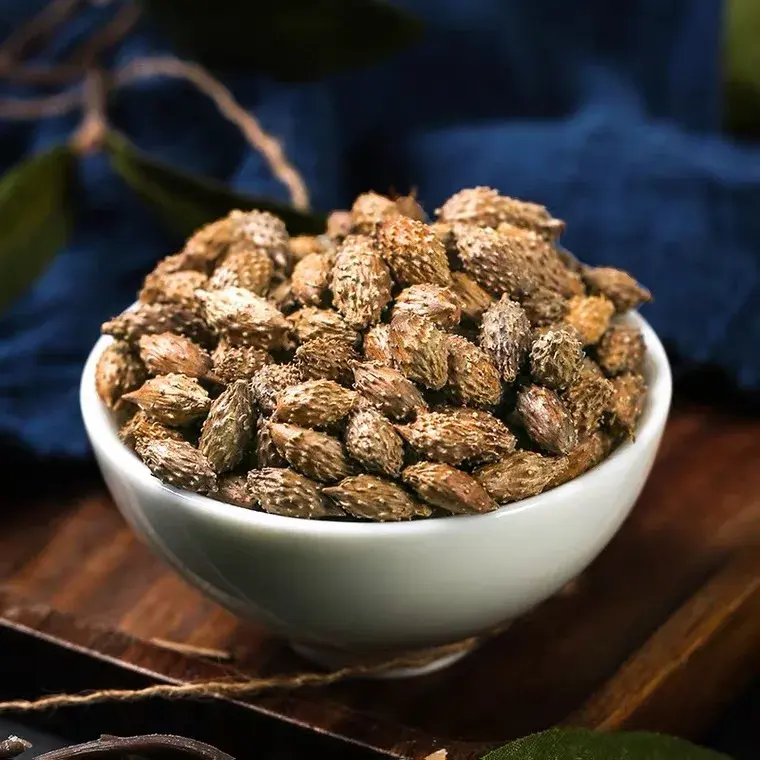




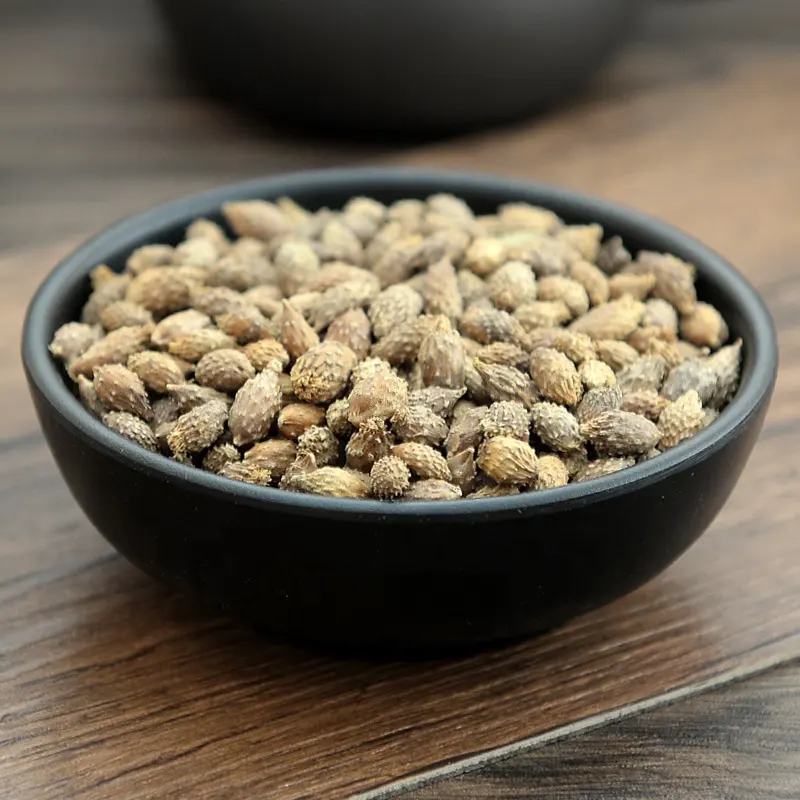
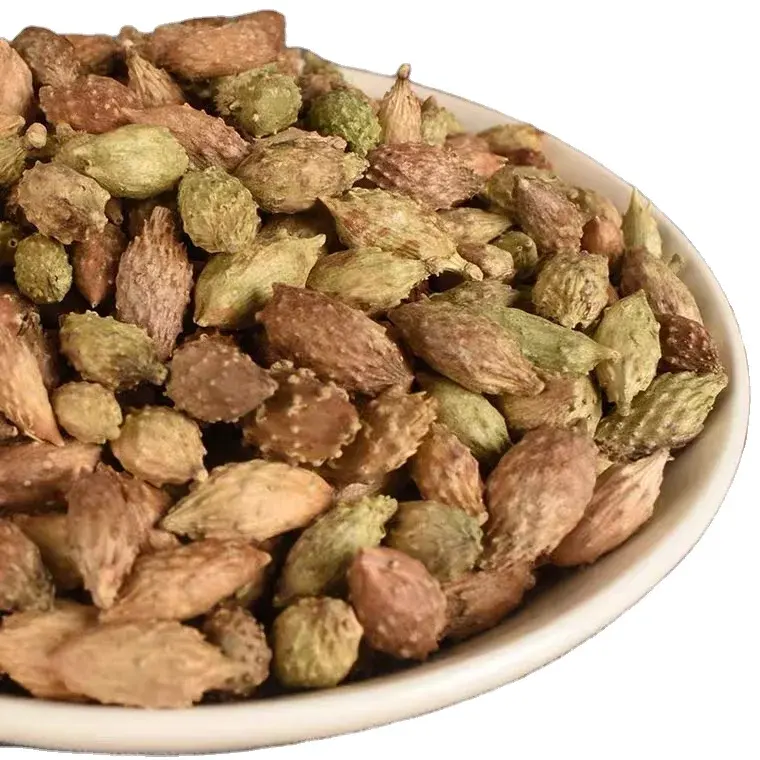
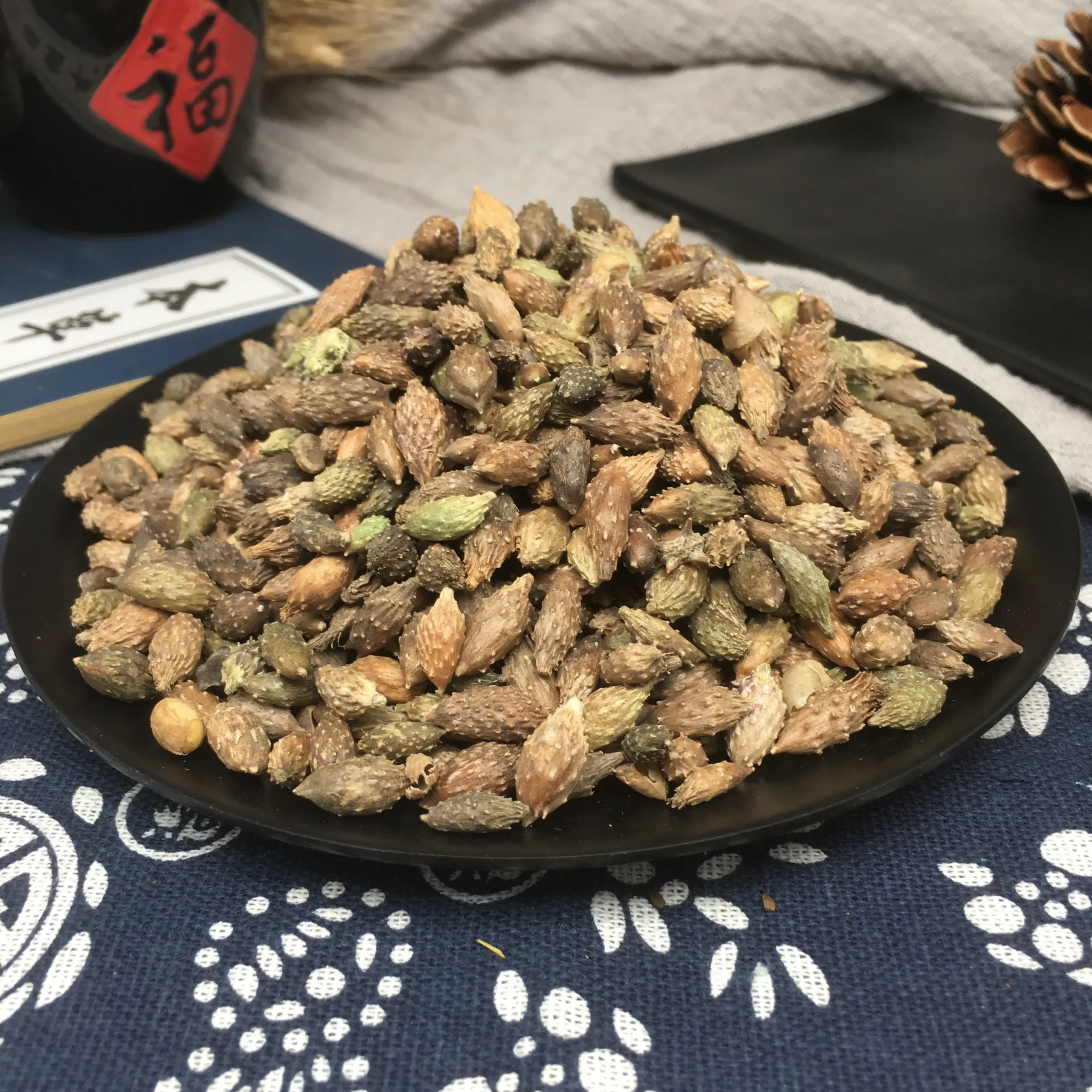

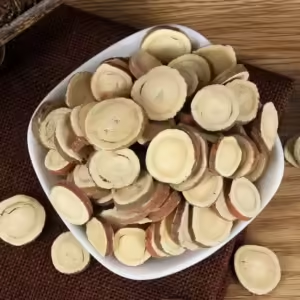

Commentaires
Il n'y a pas encore de critiques.